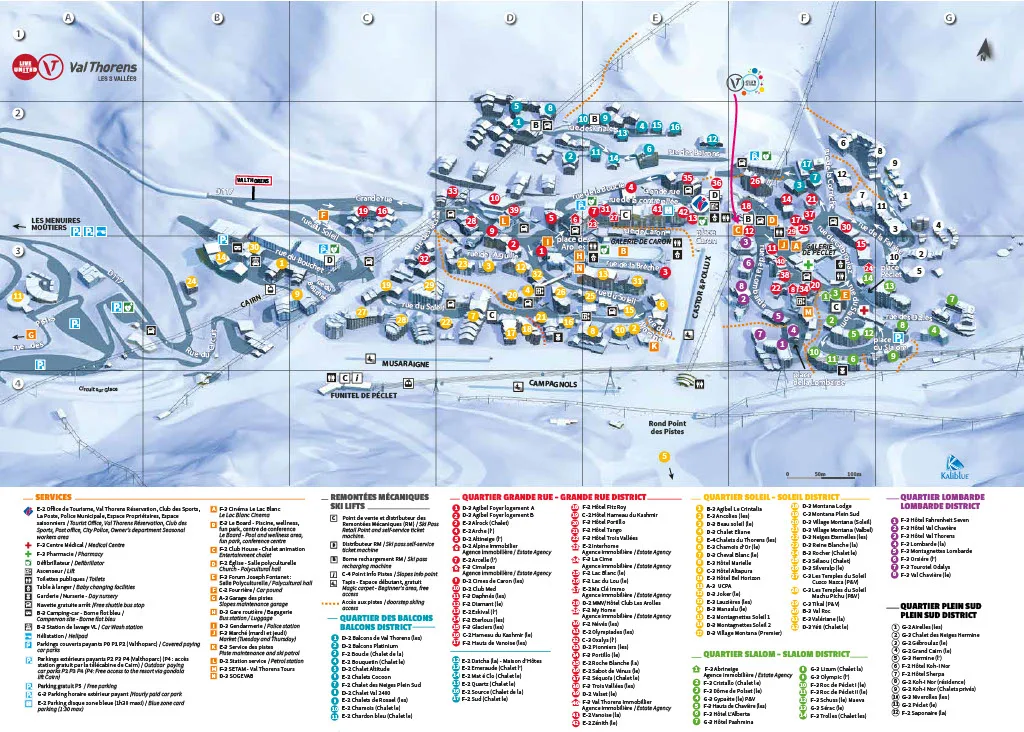

Standing proud as Europe’s highest winter sports resort, Val Thorens is a top destination among French ski resorts, beckoning ski, snowboard, and adventure enthusiasts with its impressive array of slopes and consistent snow record. Located at an altitude of 2,300 m (7,545 ft), with slopes reaching up to 3,230 m (10,579 ft), Val Thorens forms a pivotal part of the illustrious Three Valleys, offering a staggering 600 km (372 mi) of interconnected slopes.
We've put this guide together to make planning your Val Thorens ski holiday a breeze. You'll learn everything you need to know, from its location to its ski areas, snow history, and even the best spots to grab a bite or relax after a day on the slopes. At the end, you’ll also find downloadable maps of the resort and pistes, along with some handy contact numbers and links.
Ready? Let's get started!
Val Thorens is located in the Tarentaise Valley, in the department of Savoie in the northern French Alps.
Nearest airport
Transfer time
| Pros | Cons |
|---|---|
| Reliable snow conditions | In bad weather it can seem gloomy as there is no trees around |
| Easily accessed and very good beginners' slopes right in the heart of the village | Some of the village is still unattractive to walk through |
| Huge ski area for all skill levels | The pistes can get very crowded during peak weeks |
| Val Thorens accommodation is mostly is ski-in, ski-out or both | Very little to do when off the slopes |
This short video provides a glimpse of everything Val Thorens has to offer.
Val Thorens is a key part of the immense Three Valleys ski area, which includes other world-renowned ski resorts such as Courchevel, Les Menuires, and Méribel, collectively offering over 600 km (372 mi) of pistes. Within this vast network, Val Thorens itself boasts 150 km (93 mi) of ski runs covering 83 pistes (11 greens, 37 blues, 28 reds, and 7 blacks) spread across three main sectors, including:
Beginners can take advantage of a selection of gentle nursery slopes and free lifts just at the heart of the resort before progressing onto the plentiful green runs within the main ski area.
Intermediate skiers will find Val Thorens a haven, with wide, cruising blue and red runs across the Moraine and Peclet sectors.
Advanced skiers have plenty of opportunities with challenging moguls, steep black runs, couloirs, and remarkable off-piste opportunities. Noteworthy runs include the daunting Combe de Caron and the challenging mogul fields of Plan de l'Eau.
The best off-piste areas include the Glacier de Thorens, the Orelle Valley, and Cime Caron, presenting an array of demanding trails with diverse and exciting terrain.
Val Thorens snowpark, spanns over a 90,000 m² area, and it's ingeniously divided into four distinct zones, tailored for beginners, intermediates, and experts, as well as a Jump'Air zone equipped with a shock-absorbing stunt mattress. These zones offer an array of modules including whoops, wall rides, tables, and handrails for an unparalleled snowboarding experience. Adding to its snowboarding credentials, Val Thorens boasts an engaging snowboard cross located in the 2 Lacs sector.
Val Thorens is home to the stunning Glacier de Péclet, that stands at an awe-inspiring altitude of 3,561 m. This extraordinary glacier is highly celebrated for its off-piste opportunities, offering an irresistible playground for adventure seeking skiers and snowboarders.
The ski season in Val Thorens typically runs from mid November to early May. While the official 2025/26 opening and closing dates have not yet been confirmed, we’ll update this page as soon as they are announced. Please note that these dates can vary depending on snow conditions and other operational factors. Planning ahead? Don’t forget to check out our Val Thorens deals for the best offers available.
Val Thorens offers optimal snow conditions from December through April, each month presenting unique opportunities for skiers. December and January consistently bring about 35 cm (13.7 in) and 33 cm (12.9 in) of snow respectively, dispersed across roughly 2.9 days each week, ensuring regular fresh snow. February's snowfall slightly decreases to 27 cm (10.6 in) but occurs more frequently, averaging 3.1 days per week. The pinnacle of snowfall arrives in the second week of December, traditionally the snowiest week in Val Thorens, with an impressive 50 cm (19.6 in) of snow over 3.2 days, making it a paradise for those who cherish Bluebird Powder Days, when sunshine and light winds follow fresh snowfall. The season stretches into April with enjoyable conditions, accumulating 23 cm (9.0 in) of snow over 3.9 days, perfect for softer snow under brighter skies.
| Month | Snow amount (week) | Snow days (week) |
|---|---|---|
| December | 35 cm | 3.0 days |
| January | 33 cm | 2.9 days |
| February | 27 cm | 3.1 days |
| March | 29 cm | 3.4 days |
| April | 23 cm | 3.9 days |
(Ref: snow-forecast.com)
Val Thorens boasts a vibrant and diverse dining scene, offering everything from Michelin-starred establishments to cozy mountain eateries. Highlights include:
Val Thorens boasts one of the most dynamic après-ski scenes in the Alps, offering a diverse array of venues to suit every preference, from lively slope-side parties to cozy pubs and sophisticated lounges. Highlights include:

Download Val Thorens town map PDF here